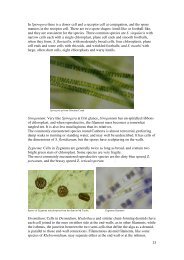Filamentous Freshwater Algae of the ACT, a preliminary list
Filamentous Freshwater Algae of the ACT, a preliminary list
Filamentous Freshwater Algae of the ACT, a preliminary list
Create successful ePaper yourself
Turn your PDF publications into a flip-book with our unique Google optimized e-Paper software.
Geitlerinema slpendidum<br />
The thallus (mass <strong>of</strong> trichomes) has crowded filaments (trichome and outer coating)<br />
lying parallel but entangled; <strong>the</strong> trichome is more or less straight, with uniform<br />
narrow cylindrical cells (its <strong>of</strong>ten difficult to distinguish end walls) except for <strong>the</strong><br />
terminal couple <strong>of</strong> cells, which taper into a conical and curved tip with a distinct<br />
button. The trichomes are very motile and appear like numerous small green rapiers<br />
at <strong>the</strong> edge <strong>of</strong> <strong>the</strong> thallus.<br />
Specimens collected from Burra and Bunyan, but probably widespread.<br />
Phormidiales:<br />
Phormidium autumnale complex<br />
This complex <strong>of</strong> similar species, in form and size and more is usually responsible for<br />
<strong>the</strong> shiny, slightly lea<strong>the</strong>ry, dark green through purple to blue-black sheets that form<br />
in <strong>the</strong> cooler months on rock or concrete especially in running water. The skin is quite<br />
strong when wet, and felty, and can be slippery; when dry it may become very shiny,<br />
but curls at <strong>the</strong> edges, and cracks in roughly rectangular pieces. It will form a quite<br />
neat blue-green fringe if left moist on a surface.<br />
The thallus is thick, with interlacing, sometimes plaited but more or less parallel<br />
trichomes; each trichome is straight and moderately long, but similar to those its<br />
growing with; <strong>the</strong> cells are cylindrical, and without a distinct sheath, and <strong>the</strong> terminal<br />
cell is broadly conical. Individual cells are generally quite distinguishable. While<br />
motile <strong>the</strong> trichomes tend to glide quietly ra<strong>the</strong>r than wave about.<br />
Specimens from Lower Tuggeranong Ck, but noted elsewhere in <strong>the</strong> river corridor.<br />
Microcoleus paludosus<br />
The muddy grey-brown flakes left behind in a drying flood-runner ate nearly always<br />
at least in part made from this species. When in shallow water, and extruded onto <strong>the</strong><br />
thallus surface, <strong>the</strong> organism gives <strong>the</strong> mud a blue, green or aeruginous hue; as <strong>the</strong><br />
pool, sandbar, flood-runner or creek bank dries, <strong>the</strong> organism retreats into its sheath<br />
complex in <strong>the</strong> mud. The sheets are quite fibrous and may resist tearing, and are felty<br />
and <strong>of</strong>ten gritty, more from <strong>the</strong> sand and mud than <strong>the</strong> organism. The organism may<br />
give <strong>the</strong> mud quite a strong geosmin (characteristic Cyanoprokaryote) smell. Left on a<br />
moist surface <strong>the</strong> edge <strong>of</strong> <strong>the</strong> sheets will show blue-green tufts.<br />
14



